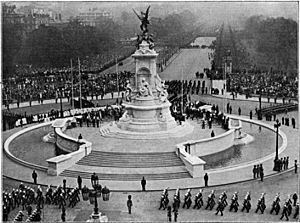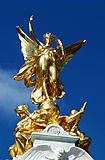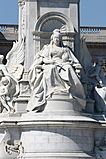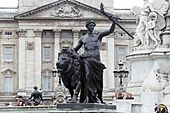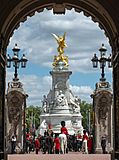Victoria Memorial, London facts for kids
Quick facts for kids Victoria Memorial |
|
|---|---|
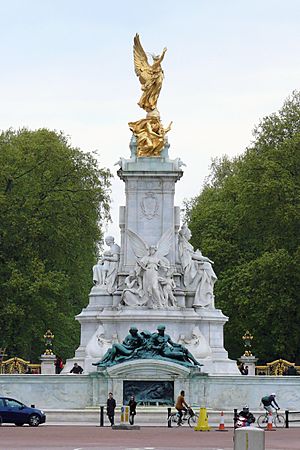 |
|
| Location | The Mall |
| OS grid reference | TQ291797 |
| Area | London, SW1 |
| Height | 25 m |
| Unveiled | 16 May 1911 |
| Built | 1901 (memorial gardens) 1906–24 (monument) |
| Restored | bronzes – April 2011 |
| Sculptor | (Sir) Thomas Brock |
| Architectural style(s) | Beaux-Arts / Edwardian Baroque |
| Governing body | The Royal Parks |
|
Listed Building – Grade I
|
|
| Official name: Queen Victoria Memorial | |
| Designated | 5 February 1970 |
| Reference no. | 1273864 |
| Lua error in Module:Location_map at line 420: attempt to index field 'wikibase' (a nil value). | |
The Victoria Memorial is a large monument in London, England. It honors Queen Victoria, who was a very important ruler. The famous sculptor (Sir) Thomas Brock designed it. The memorial stands at the end of The Mall, right in front of Buckingham Palace.
Work on the memorial began in 1901, but it was officially shown to the public on May 16, 1911. The entire project, including the surrounding gardens, was not finished until 1924. This memorial was a big part of a plan to make the area around Buckingham Palace look grander. This plan also included changes to the palace itself.
Like the Albert Memorial, which honors Victoria's husband, the Victoria Memorial has many detailed sculptures. The main part of the memorial is made from special marble. Other statues are made from different types of marble and shiny bronze. The whole memorial is very heavy, weighing 2,300 tonnes. It is also 104 feet wide. In 1970, it was given a special Grade I listing, meaning it is a very important historic building.
Contents
Victoria Memorial: A Royal Monument
How it Was Planned and Built
Ideas and Decisions
After Queen Victoria passed away, King Edward VII wanted a special memorial built for her. He created a committee to plan it. Their first meeting was in February 1901. At first, the meetings were secret. But soon, the Lord Mayor of London announced that the memorial would be "monumental." This meant it would be very grand.
Many places were suggested for the memorial. The King even visited Westminster Abbey and a park near the Palace of Westminster. Some early ideas included a new open space in The Mall. Another idea was a memorial in Green Park.
On March 26, 1901, the committee decided. The memorial would be placed right outside Buckingham Palace. They also decided to make The Mall a little shorter. They thought the project would cost about £250,000. It was decided that the government would not pay for it. Instead, money would be raised from the public.
After the location was chosen, a design competition was held. Five architects were asked to create designs. By July 1901, the committee picked their favorite design. They showed it to the King for his approval. On October 21, 1902, it was announced that Thomas Brock was the chosen designer. The cost was expected to be around £200,000.
Getting the Money
Money for the memorial came from all over the British Empire. People and governments from different countries helped. For example, Australia gave £25,000 in 1905. New Zealand sent £15,000. By October 1901, about £154,000 had been collected. Even some tribes from West Africa sent goods to be sold. The money from these sales went to the fund.
More money was collected than was needed for the Victoria Memorial. So, the extra funds were used for other projects. Some money went to build Admiralty Arch at the other end of The Mall. This arch helped create a direct path to Trafalgar Square. Sir Aston Webb, the same architect who designed parts of the memorial area, led this project. He built the Arch so well that there was still money left over. This extra money was used to give Buckingham Palace a new stone front. This big job was done very quickly, in just 13 weeks.
Building the Monument
The first step was to change the road and reshape The Mall. Thomas Brock hoped to start building the memorial itself around 1905. The bottom part of the memorial was shown to the public on May 24, 1909. Thousands of people came to see it on the very first day.
Unveiling and Special Events
The Grand Opening
Before the main event, a practice ceremony took place on March 11, 1911. The official dedication ceremony happened on May 16, 1911. King George V led the ceremony. His cousin, Wilhelm II of Germany, was also there. Both were grandsons of Queen Victoria. They arrived with their families in a royal parade. Many members of Parliament and military representatives also attended.
Winston Churchill, who was the Home Secretary at the time, carried the speeches. Lord Esher spoke to the King and the crowd. He explained the history of the memorial. The King then spoke about his grandmother, Queen Victoria. He talked about her impact and how much people loved her. The ceremony lasted for 30 minutes. Afterward, it was announced that Thomas Brock, the sculptor, would be made a knight.
Modern Celebrations
The Victoria Memorial is still used for important events today. For Queen Elizabeth II's Golden Jubilee in 2002, the memorial was part of a big fireworks display. The show lasted 14 minutes and used a lot of fireworks. Water jets were also added to the memorial's fountains. These jets shot water 40 feet into the air. This display happened after a concert at Buckingham Palace.
In February 2012, it was announced that the Victoria Memorial would be the main stage for Queen Elizabeth II's Diamond Jubilee Concert. This concert took place on June 4, 2012. Special platforms were built around the memorial for the performers. Many famous artists performed, including Gary Barlow, Tom Jones, Elton John, and Paul McCartney. Tickets were free and given out by a lottery. About 10,000 fans watched live, and the event was shown on TV around the world.
Later in 2012, the memorial was the end point for "Our Greatest Team Parade." This parade celebrated the success of British athletes at the 2012 Summer Olympics and Paralympics. About 800 athletes rode on 21 floats. Around a million people cheered them on. The area near the memorial was reserved for ticket holders. After the parade, there was a flypast by helicopters and jets. During the Olympic Games, the Mall and the Victoria Memorial were used for the marathon finish line and the triathlon route.
The memorial has also seen some protests. On November 5, 2013, during a protest in central London, the memorial was damaged. The next year, police officers guarded the memorial during similar protests.
What Does it Look Like?
Important Figures
At the very top of the central part of the memorial is a golden bronze statue. It is called Winged Victory. This figure stands on a globe and holds a palm branch, which is a symbol of winning. Below her are two other figures: Constancy, who holds a compass pointing north, and Courage, who holds a club. Below these, on the east and west sides, are two eagles with their wings spread. These eagles represent the British Empire.
Even further down, there are more statues. One is of an enthroned Queen Victoria, facing The Mall. Another is Motherhood, facing Buckingham Palace. There is also Justice, facing towards Green Park, and Truth, facing the other way. These statues were carved from huge blocks of marble. The Truth statue was made from a block weighing 40 tonnes.
Symbols and Meanings
Thomas Brock, the sculptor, explained what the memorial's sculptures mean. He said it was dedicated to the "qualities which made our Queen so great and so much beloved." He added that the statue of the Queen faces the city because she was "just and that she sought the truth always." The Motherhood statue represents her "great love for her people."
At the four corners of the monument, there are large bronze figures with lions. These figures represent important ideas:
- Peace: A female figure holding an olive branch.
- Progress: A young person holding a flaming torch.
- Agriculture: A woman in farm clothes with a sickle and a bundle of corn.
- Manufacture: A blacksmith in modern clothes with a hammer and a scroll.
The last two groups have a small message carved into their bases: "THE GIFT OF NEW ZEALAND."
The entire memorial has a theme related to the sea. This is like other parts of The Mall, such as Admiralty Arch. You can see this theme in the mermaids, mermen, and a hippogriff. These creatures remind us of the United Kingdom's strong naval power.
The memorial is surrounded by beautiful gardens and gates. These were also designed by Sir Aston Webb. At almost 25 meters (82 feet) tall, the Victoria Memorial is the tallest monument to a King or Queen in England.
Images for kids
See also
 In Spanish: Victoria Memorial (Londres) para niños
In Spanish: Victoria Memorial (Londres) para niños


